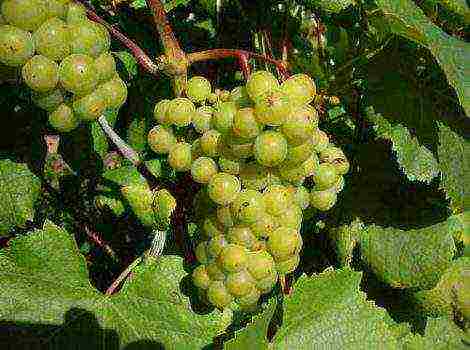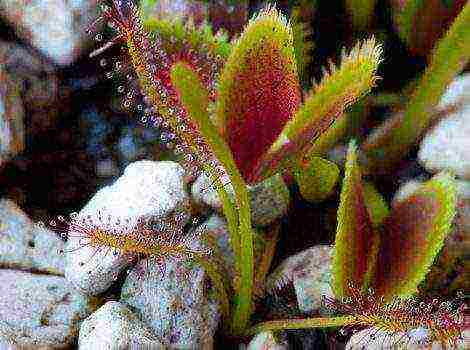Content
- 1 How to grow red and black currants?
- 2 Timing for landing at their summer cottage
- 3 Planting and growing currants
- 4 Planting methods
- 5 Landing rules
- 6 Care
- 7 Loosening
- 8 Watering
- 9 Top dressing
- 10 Prevention of diseases and pests
- 11 Preparing for winter in the country
- 12 Soil and lighting requirements
- 13 Landing time and scheme
- 14 Seedling selection and site preparation
- 15 How to plant currants correctly
- 16 Soil processing and watering
- 17 Top dressing
- 18 Pruning
- 19 Supports and preparation for winter
Currant is a very useful berry, most often it is used to prepare various compotes and juices, it is also a part of various jams and preserves.
Growing such a plant in a summer cottage is quite simple. Also, red currant is a rather unpretentious plant.
How to grow red and black currants?
In order for red or black currants to develop well and bring abundant and annual harvests, it is necessary to choose the right place for planting so that the shrub is comfortable:
- currants are not recommended to be planted in places where old bushes of this culture or gooseberries grew before;
- the groundwater level should be no higher than 1.5 meters, otherwise the root system may rot or even die;
- it is also not recommended to plant currants in low-lying places where rainwater or melted snow accumulates;
If it is impossible to plant a shrub in a dry place, you can drain it with expanded clay. Such a tool perfectly restrains excess moisture.
- the health and productivity of a shrub directly depends on the amount of sunlight. In the absence of these indicators, the plant begins to hurt and ceases to resist pests, the berries become smaller or disappear altogether;
- gusty winds have the same effect on currants, so the place should not only be not shaded, but also protected from northerly and easterly winds. For growing bushes, no special agricultural technology is needed. Everything can be done by hand.
Currants grow well in almost any soil, the exceptions are:
- sandy soil;
- rocky ground;
- swampy areas.
Also, this culture prefers neutral soil, therefore, in the presence of acidic soil, it must be preliminarily limed. To do this, 400 grams of crushed limestone or 300 grams of slaked lime is added to one square meter of land.
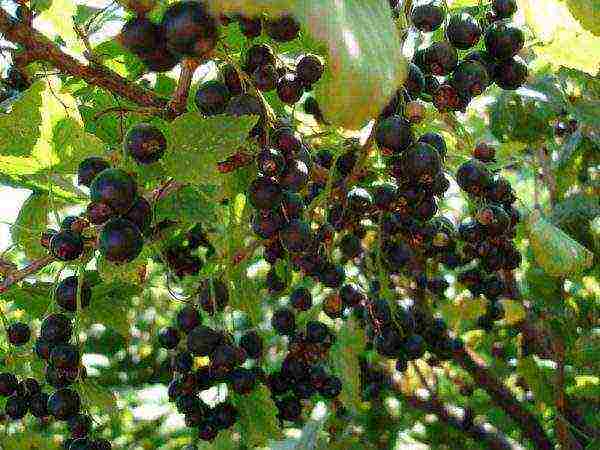 Juicy and ripe bunches of black currants
Juicy and ripe bunches of black currants
Timing for landing at their summer cottage
Currants can be planted both in spring (late March - early April) and in autumn (mid September - early October). But experienced gardeners recommend doing exactly the autumn planting, because it has a lot of advantages:
- Saplings manage to take root before the onset of cold weather and tolerate winter frosts well. And when this procedure is carried out in the spring, the shrub is actively developing the root system, but it also spends energy on growing foliage and leaves to winter in a weakened form, because of which it may not endure the frosty weather and simply die;
- Also, plants planted in autumn move faster and, accordingly, begin to bear fruit faster.
For the southern and central regions, autumn planting is more suitable, and in the North or the Urals, red and black currants are planted in spring, so that the root system can get stronger, but at the same time it is necessary to remove all the buds in a timely manner so that there is no foliage on the seedling.
Planting and growing currants
Soil preparation
The initial stage of planting currants is considered to be timely soil preparation:
- When carrying out an autumn planting, the pit is prepared about 3-4 weeks before the procedure itself., and for spring planting, a hole must be dug in September. Preliminary preparation is needed in order for the soil to become more fertile;
- Given the biological structure of the root system of red currants, the depth and width of the pit is usually 40-50 centimeters;
- While digging a hole, the bottom layer is folded separately from the top. Then the fertile (upper) earth is mixed with:
- 2 buckets of compost, humus or rotted compost;
- 100 grams of superphosphate;
- 90 grams of potassium sulfate.
- In this form, the planting hole is left until the seedling is planted.
It is best to buy seedlings a few days before planting and follow all transportation rules. To do this, the roots of the plant are first moistened, then wrapped in burlap and the resulting structure is strengthened with a plastic bag.
Planting methods
Single landing
With this planting, currants bring the greatest amount of harvest and live much longer than with other methods. Experienced gardeners recommend planting plants at least two meters away from other trees and shrubs.
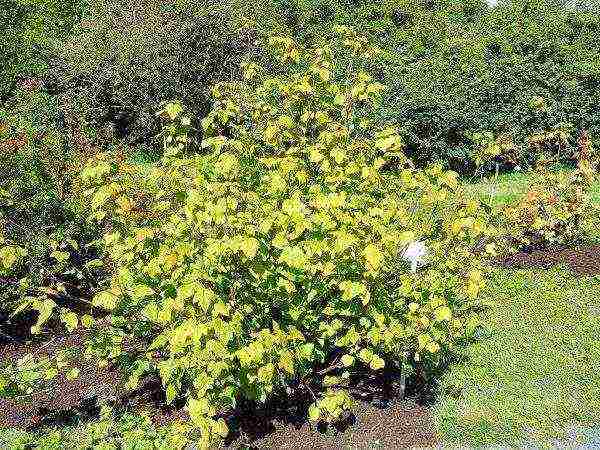 Sprawling currant bush
Sprawling currant bush
Ordinary landing
This method is suitable for those gardeners who want to collect the maximum number of berries from the smallest areas. Usually the row planting is used in the commercial cultivation of red currants. The only drawback is the rapid wear of plants and, accordingly, their rapid death.
Using this method, the characteristics of each variety should be taken into account and shrubs with a lush crown should be planted at a distance of 120-150 centimeters, and plants with a more compact arrangement of shoots at a distance of 70-110 centimeters.
Landing on a trellis
To achieve the desired effect, shrubs are planted at a distance of 50-100 centimeters from each other. After 2-3 years, the branches of the currant are fixed on the installed trellis. In this case, you can get a solid fruiting plane.
Instead of special trellises, you can use a fence that encloses the site.
Landing rules
The technology for planting black currants is as follows:
- It is best to place the seedling in the hole at an angle of 45 degrees, but a vertical landing is also possible, which is much easier and more familiar;
- The root collar should be 5-6 centimeters buried in the ground;
- when digging a hole, you should periodically shake the seedling in order to avoid the formation of air pockets between the roots of the plant;
- At the next stage, the earth must be carefully tamped.
- For a plant to take root well in a new place, it is not enough just to plant it correctly... It is necessary to provide proper care for the young bush:
- Immediately after planting, a small groove is dug around the currants, into which a bucket of water must be gradually poured. Such a procedure will not only moisten the soil, but also improve the contact of the roots with the soil;
- After the water dries up, the groove is filled with humus, peat, or just dry earth;
For such a procedure, in no case should you use mineral fertilizers and fresh manure, because they can cause burns on the root system and the plant will die in the first year.
- Also, the ground around the bush can be mulched to a height of 5-10 centimeters;
- To speed up the formation of the crown of the shrub and avoid the appearance of weak growths immediately after planting, all branches of the plant are shortened to 2-4 buds.
Proper planting procedure is the main key to success in growing healthy shrubs and obtaining a rich harvest.
 Young red currant bush
Young red currant bush
Care
In order for the shrub to give as much yield as possible, you need to properly care for it and not neglect even the seemingly insignificant procedures.
Loosening
The ground around the shrub must be periodically loosened so that the root system receives the required amount of moisture and oxygen. In the root zone, loosening is carried out to a depth of 5-6 centimeters, gradually increasing the depth to 15 centimeters as it moves away from the base of the plant.
Watering
Currants are capable of withstanding a short-term drought, but to obtain bountiful harvests, you need to maintain 80 percent soil moisture, to check this indicator, you can dig out the ground at a depth of 30 centimeters, when compressed into a lump, it must retain its shape.
During watering, you need to saturate the soil with moisture by 40-50 centimeters, for this a young shrub will need 2 buckets of water, and an adult 4-5. There are several ways to water:
- you can dig a groove around the plant and gently pour water into it;
- for large landings, a trench is pulled out and a hose filled with water is installed in it.
After watering, it is recommended to mulch the soil.
Top dressing
In order for a bountiful and large harvest to start on the bush, it is necessary to timely make various top dressing that feed the soil. In the first 2 years after planting, there is no need to fertilize the soil, the plant will have enough nutrients introduced during planting.
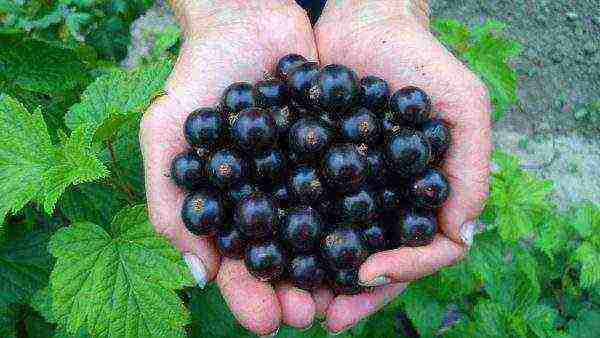 Harvest of ripe black currant berries
Harvest of ripe black currant berries
Prevention of diseases and pests
To avoid the appearance of diseases and pests, it is necessary to treat the shrub with special preparations and carry out sanitary and thinning pruning.
In the spring:
- Currants are watered once in early May, but if the winter turned out to be with little snow, and the spring was dry, then this procedure is postponed to April;
- Immediately after the snow melts, it is necessary to carefully loosen the ground;
- In the spring, the tree is treated for diseases and pests with the help of special preparations or Brodsky liquid;
- During this period, it is imperative to carry out thinning pruning, removing all frozen, damaged or unnecessarily thickening branches.
At the beginning of leaf blooming, currants are fertilized with 50 grams of urea and 500 grams of wood ash. Top dressing is scattered under the bush, and then carefully buried. It is worth remembering that moisture is needed to dissolve fertilizers, so if the ground is dry and there has not been any precipitation for a long time, then the procedure should be carried out after abundant watering.
During flowering, red currants are fertilized with a complex mineral fertilizer and poultry droppings.
Currants do not tolerate chlorine, so you need to be very careful about the selection of fertilizer and use sulfate instead of potassium chloride.
Also, in the spring, the shrub must be fed with organic fertilizers (humus, compost, manure, etc.). On fertile soils, this procedure is carried out once every 3 years, but on poor lands it will have to be repeated annually.
Summer:
- In the summer, the shrub needs to be watered as the soil dries up; in normal weather and the absence of drought, the procedure is carried out 1 time in 2 weeks;
- Experienced gardeners recommend loosening the soil slightly after each watering;
- Also, in the summer, you need to monitor the cleanliness of the root zone and remove all weeds.
- During the formation and filling of fruits, currants can be sprayed with growth stimulants, but the safest and most effective method is the application of liquid fertilizers after flowering. Such fertilizers include liquid fertilizing with infusion of mullein, bird droppings or slurry.
- Many gardeners use infusions prepared on the basis of various herbs, fruit peels, etc. as summer feeding. These products can be used all the time and added with every watering.
In autumn:
- In autumn, the amount of watering is reduced to zero, it will be necessary to apply an abundant amount of moisture when preparing the shrub for winter;
- It is also recommended to loosen the ground in the fall so that the roots receive as much oxygen as possible in the winter;
- It is very important to carry out sanitary pruning in the fall, during which all dry, diseased and damaged branches will be removed. This is necessary in order to get rid of diseases and pests;
- After harvesting, under the shrub, add:
- 50 grams of superphosphate;
- 20 grams of potassium sulfate;
- Organic fertilizers (on fertile soils once every 2 years).
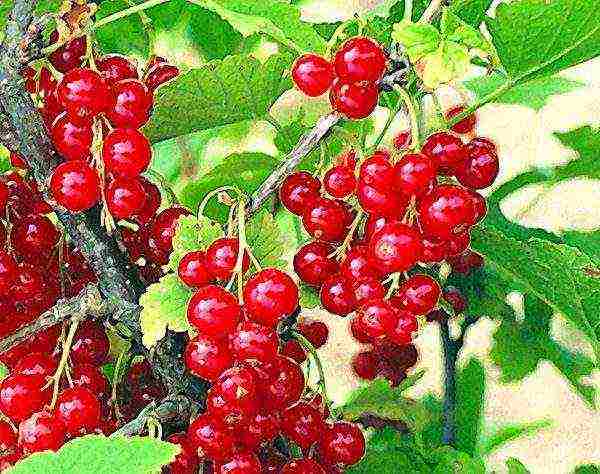 Bunches of ripe red currant berries
Bunches of ripe red currant berries
Preparing for winter in the country
Although black currant is a fairly winter-hardy crop, it still needs additional protection in the winter. To do this, you can use one of the following methods:
All branches of the bush must be carefully bent to the ground and the number of bricks must be placed on top, which will serve as a load. When carrying out such a procedure, it is very important not to harm the branches of the plant. Snow is a natural defense against harsh temperatures, so this method is only possible during a snowy winter.
You can also wrap each branch of the shrub in a special agrofiber, while it is advisable to add insulation in the form of mineral wool. This tool is great for severe frosts or at a time when there is no snow cover.
Red and black currants are a wonderful berry, juice or compote from which can easily quench your thirst on a hot day, and the jam made with these fruits has a pleasant and unusual sourness. Currant brings abundant harvests, and growing it in the country will allow you to collect a huge amount of ingredients for processing from one bush.
And at the end, a short video on how to grow currants:
There are many types of berry bushes found in summer cottages. But in the list of preferences of their owners, black currant is in the first place: its planting, like caring for plants, does not cause difficulties, it is not afraid of harsh winters, it begins to bear fruit early and thanks the owner for years for taking care of generous harvests. It is easy to propagate it, and you can do it in different ways. And everyone knows about the benefits of its berries and leaves.

Soil and lighting requirements
Black currant is one of the most viable crops. It can grow almost anywhere. On the sand, in thick shade or in flooded lowlands, its bushes will turn out to be less lush, but even in such conditions they will not die. The plant will be most comfortable in areas open to sunlight with moderately moist soil, protected from wind and drafts.
A shrub is also planted in light partial shade. But in this case, expectations about the harvest should be reduced: the lack of light will make the black currant berries more acidic and reduce their number. To understand whether the chosen place is suitable for the plants, their appearance will help. In favorable conditions, they branch well, and their leaves are rich in color and look healthy.
Planting currants in fertile loose soil will be productive. It should freely allow air to flow to the plant roots and retain moisture. Light loam is an ideal option for a shrub. In dense soil, its development will slow down and yield will decrease. It is important to consider the reaction of the soil. It should be slightly alkaline or neutral. Currants do not like sour soil. Such soil will have to be limed before planting.
The culture is hygrophilous, but it grows and bears fruit poorly in swampy soil. It is best to plant shrubs on gentle slopes. It will be unsuccessful to place it in closed lowlands or on sand, as well as on lawns. The distance to groundwater should be at least 0.5-1 m.
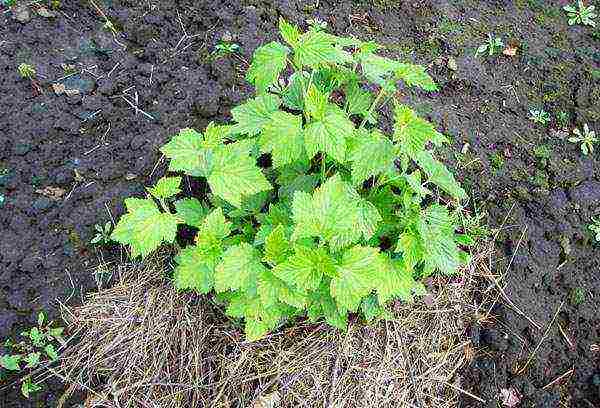
Landing time and scheme
Black currants are planted in spring and autumn. Basically, summer residents prefer the second option. Bushes placed on the plots in the spring begin to grow quickly, so it is more difficult for them to root. There is one trick in which planting black currants at this time will be successful. For her, you need to choose plants whose root system is closed.They take root easier and faster in the open field if they are watered abundantly. You can place them in summer cottages at almost any time.
Autumn planting in the middle lane is usually carried out in early October, at the latest in the middle of the month. Under the weight of the snow, the earth around the currant bushes will be compacted in a natural way. In the spring, they wake up early and show rapid growth.
Planting black currants in a row has already become a tradition. This placement makes it easier to care for her bushes and saves space on the site. 1-1.25 m are left between neighboring plants. Some summer residents increase this distance to 2 m. It is important to take into account the proximity of other shrubs and trees when planting. At least 1.5-2 m retreat from the first, 3-4 m from the second. Currants grow quickly. When only 3-4 years have passed, the seemingly bare area will be unrecognizable.
Advice
If you want to get the harvest earlier, you can leave less space between the bushes (70-80 cm). With a dense planting, they will begin to bear fruit after 2-3 years, but fewer berries are formed on them, and they will grow old faster.
Having decided to place the currants near the fence or walls of buildings, you need to leave enough space for it. The minimum distance to them is 1.2 m. It will not be possible to harvest from the branches pressed against the fence.

Seedling selection and site preparation
Preparing a place in the country for currant bushes will not take much time. If earlier this site was used for growing vegetable or flower crops, it is simply well dug up, going deeper by 1 bayonet of a shovel and picking out the roots of perennial weeds from the soil. Deep depressions or pits are covered with soil, carefully leveling the surface.
Planting black currants correctly means taking into account the peculiarities of crop rotation. In order for the plants to have enough nutrients and they are less sick, the culture is returned to the previous site only after 3 years. The same recommendation is adhered to if gooseberry bushes used to be at the planting site.
For those who don't have time to wait, there are 2 options:
- find another site;
- depart from the old at least 1 m.
When choosing a seedling, they carefully examine it. A viable plant has lignified and branched roots. 3-5 of them should be skeletal and at least 15-20 cm long. A quality seedling has 1-2 (or more) 30-40 cm branches. The plant should look fresh and free from signs of infection and pests.
Pay attention to the specific characteristics of the variety:
- its compliance with the climate of the area;
- the presence of immunity to diseases;
- frost resistance.
The harvest will be more plentiful, and the berries will be larger if you plant several varieties of crops in the country. This rule applies even to self-fertile blackcurrant species. Planting in areas of plants with different flowering periods will help to insure against recurrent frosts. So even in a cold spring, it will be possible to get a harvest from at least a few bushes.
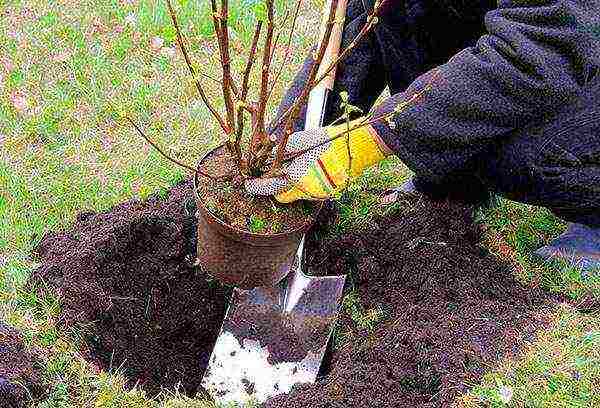
How to plant currants correctly
Planting currants begins with the preparation of the pit. It is usually made shallow (35-40 cm) and wide (50-60 cm in diameter). If the soil in the country house is poor, the size of the pit is increased so that it can be filled with a nutritious substrate. Lay it out in 2 layers. Fertile soil is poured at the bottom, adding the following components to it:
- compost;
- rotted manure (peat can be used instead);
- wood ash or potassium sulfate;
- superphosphate.
About ¾ of the pit volume is filled with this mixture. It should be under the roots of the seedling. The rest of the deepening will be occupied by simple fertile soil without fertilizers. Having sprinkled a nutritious substrate with it, they begin to plant a plant.
Its roots are examined. If damaged or dry areas are identified, they are trimmed to healthy tissue. With proper planting, the bush will be 5 cm below the mark at which it grew up to it.The root collar should be underground (at a distance of 6-8 cm from the surface). This will give an impetus to the intensive formation of basal buds, and the bush will grow lush.
The next step is abundant watering. ½ a bucket of water is brought into the pit itself and the same amount into the hole, which is made at the landing site. Then the soil under the bushes is mulched without covering the plants themselves.
As mulch, you can use:
- peat;
- compost;
- straw;
- sawdust.
The recommended thickness of a mulching layer made of organic materials is 5-8 cm. If they are not at hand, use dry soil. It is poured in a thinner layer (1-2 cm). Planting ends with pruning of the plant. Only a stump is left from it, which should rise 7 cm above the soil surface.Do not spare the seedling. Already next year it will turn into a small but branched bush. Without pruning, it will take a season longer to wait.
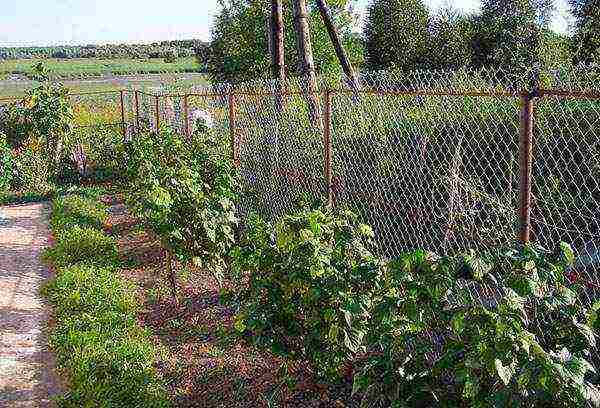
Soil processing and watering
Legends can be made about the unpretentiousness of black currant. But so that the plantings do not overgrow, and the yield does not fall, you still have to take care of them. The bush does not like the neighborhood of weeds. They are its main competitors in the fight for moisture and nutrients. Best of all, currants feel on a soil clean from any other plants.
It is impossible to spray herbicides near currant plantations, so there are 2 ways to remove weeds:
- weeding;
- mulching.
"General cleaning" of competing plants is carried out twice a season: in spring, when fertilizers have already been applied, and in summer, when the last berries are harvested.
Black currant responds well to soil loosening. Any garden tools are used for him: a hoe, a shovel, a pitchfork. Near the root collar, the soil is cultivated to a depth of 6-8 cm. Under the bushes, loosening is made more intense, affecting a 10-12-centimeter layer of earth. If the trunk circle is mulched, the soil remains moist longer and the frequency of loosening is reduced.
The roots of the shrub are located shallowly - only 50 cm from the soil surface. Therefore, currants cannot do without watering for a long time. Saplings and young bushes especially suffer from lack of water. Adult plants need regular moisture in June, when shoots are actively growing and berries are poured, and in late summer-early autumn, when flower buds of the next season are laid. Drying out of the soil during this period will lead to shedding of unripe berries and crushing of the remaining ones. It will also negatively affect the harvest of the next year.
If the summer is dry, the plantings are watered often (at intervals of 7-10 days) and abundantly. For each plant, they spend 1.5-2 buckets of water. It is more convenient to water in the grooves. They are dug around the bush, stepping back 20-25 cm from the tips of its shoots. If it rains periodically, 4-5 waterings per season will be enough for adult plants. Loves currants and leaf spraying. On hot days, it is better to spend them more often.

Top dressing
With proper preparation of the planting pits, the cultivation of black currants on the site in the first 2 years does without feeding. When this milestone is passed, the plants will have to be fertilized annually. Some summer residents feed the plantings less often - once every 2 years. Currant reacts equally well to mineral and organic compounds. They are brought in mainly in the fall or early spring. Spreading humus or compost (4-5 kg per plant) and complex mineral fertilizer (about 40 g) under the bushes, they loosen the soil.
Closer to the end of spring (but before the beginning of summer), when the currant bushes enter the phase of active growth, one more root dressing is carried out. To do this, it is good to use one of the following means:
- manure diluted with water in a ratio of 1: 8;
- poultry manure solution (1 part fertilizer per 10 parts water);
- infusion of herbs.
The nutrient composition is poured into the grooves, immediately sprinkling them. Each plant takes 1.5-2 buckets.The introduction of complex mineral fertilizers at this stage will be less useful, but you can use it as well.
With the onset of flowering, currant bushes are watered with infused potato peel. The starch contained in it will increase the productivity of plants. A solution is prepared from dried potato peelings. They are added to boiling water (in a ratio of 1:10), covered with a lid and, having wrapped the container well, left to cool completely. For each currant bush spend 1 liter of the resulting composition.
Advice
In September, plantings are fed with phosphorus-potassium preparations. They will help plants survive the winter with minimal damage.
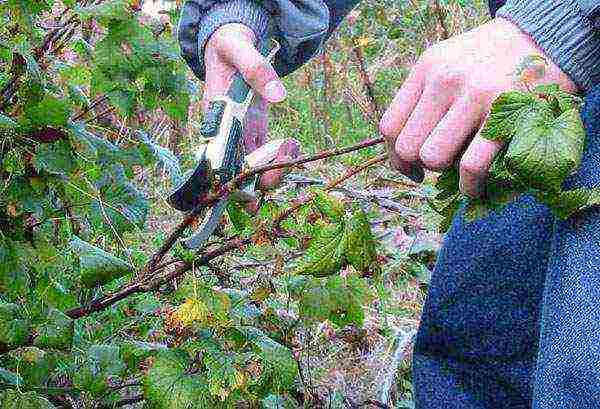
Pruning
Growing black currants in the country involves regular pruning. It is most convenient to carry them out in the fall, when the bush is completely naked, exposing old and unnecessary branches. Young (less than 5 years old) shoots are left on an adult plant. Old branches are cut strictly at the level of the soil, leaving no stumps. The wound is treated with garden varnish.
Young shoots get rid of only in extreme cases - if they:
- injured;
- are sick;
- poorly developed;
- thicken the bush.
Young plants also need pruning. In the first years of life, a bush is formed in a permanent place, shortening its shoots to 10-15 cm. After the procedure, 2 to 4 developed buds should remain on them. The next year, they get rid of small shoots, simultaneously removing weak branches. The skeleton of the bush begins to form, leaving a maximum of 4 well-developed zero-order shoots.
A year later, the main focus is on the branches of the first order. Of these, the 5 most powerful are kept on the plant, and the rest are removed. By the age of 4-5, the currant bush should have 15-20 skeletal branches. In the future, the task of the gardener becomes their sanitary and rejuvenating pruning, which is carried out annually.
Supports and preparation for winter
In many varieties of currants, the bushes grow sprawling. This makes it difficult to care for them and leads to the fact that part of the crop is soiled in the ground. It is convenient to place supports under such bushes. You can buy ready-made in stores or make them yourself. The easiest option is to drive stakes around the plant and pull off the branches with twine. But here it is important not to overdo it. Currant shoots should not be pressed against each other. That's right, if there is a lot of free space between them.
After the autumn feeding, the planting is spud. If the soil in the area is heavy, it is better to dig it to a shallow depth without breaking lumps. This will keep more moisture in the ground. Light and loose soil in the near-trunk circles can simply be loosened well by 5-8 cm. But you cannot do without digging the row spacing (by 10-12 cm). Watering is also mandatory at this time, especially if the autumn is dry. Under each plant, add 20-30 liters of water.
Before the onset of cold weather, it is advisable to tie the bushes with a rope or twine so that the branches do not break and do not bend to the ground under the weight of the snow. You can build a kind of fence of stakes around them. In winter, the bushes are covered with a thick layer of snow.
With the arrival of heat, the plants should be carefully examined. Frost-beaten branches are cut out, and the remaining ones are treated with Bordeaux liquid (1%). It is worth paying attention to the swelling kidneys. They can be infected with a tick. Signs of its presence are a strong enlargement of the kidneys, their inflated, rounded shape. You cannot leave such shoots on the bush, they must be removed immediately and burned.

Agrotechnology of black currant is simple, but its observance will allow you to get rich yields of tasty and healthy berries. From planting this particular shrub on the site, inexperienced summer residents should start their experiments. Currants, like no other culture, are tolerant of the mistakes of the owner. Neither overflow, nor lack of nutrition and moisture, nor frosty winters, nor improper pruning will be able to ruin it.
The reproduction of the bush will not bring trouble either.6-year-old plants are the most productive, therefore, professionals in summer cottages do not allow plantings to grow old. When the currant bush reaches 3 years of age, cuttings are cut from it or the branch is bent to the ground and added dropwise to obtain layering. They are deposited in a separate area. By the time the yield of the mother plant decreases, the first berries will already be tied on young bushes.
Black currant - a popular garden culture, extremely healthy and tasty. Currants are widely used in households: they are eaten fresh, jam, jams, jellies are made, and canned.
Berries are used to prepare compotes and juices, various tinctures, liqueurs and wines. From the article you will learn when and how to plant currants, avoiding planting to picking berries, properly pruning bushes, propagating by cuttings, pest control, popular varieties of currants.
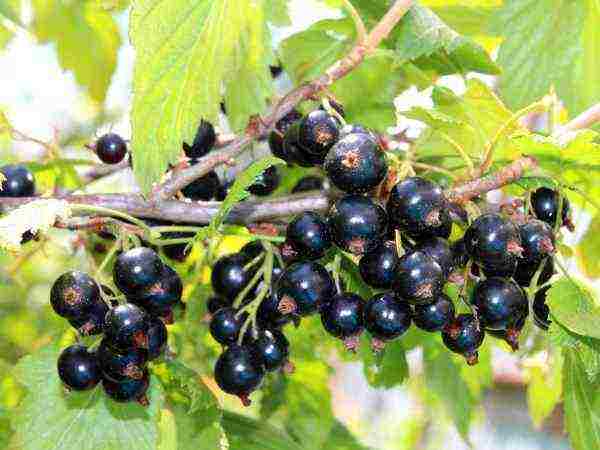
Content:
Currant - description of the plant
Planting currants
How to care for black currants
- Currant care in spring, summer, autumn
- Treatment against pests and diseases
- Watering currants
- Top dressing of currants
When and how to cut currants
- Pruning in spring
- Pruning in the fall
Correct pruning of currants - video
Reproduction of currants
- Lignified cuttings
- Green cuttings
Black currant diseases and pests
Care and pest control without chemistry - video
Currant varieties
Currant - description of the plant

Perennial shrub from the gooseberry family. The height of the bushes is up to 2 meters with fluffy pale green shoots that change color with age to brown.
The root system is fibrous, reaching a depth of 20-40 cm.
The currant bush consists of branches of different ages, located at different levels, thanks to which the currant bears fruit for 12-15 years.
In the spring, at a temperature of +5 degrees, the buds swell, flowering appears at +11 +15 degrees, because of this it is affected by spring frosts.
Most of the varieties of currants do not need pollination, they are also frost-resistant. Currant leaves are used in conservation (very fragrant), and they are also used for brewing tea.
The berries are sweet and sour in taste, with a strong aroma, rich in vitamins and microelements. The high content of vitamin C makes currant berries very useful, a good remedy for the prevention of diseases.
Planting currants

When to plant black currant cuttings
Currant propagates by cuttings, layering, dividing the bush. Young green cuttings take root and begin to grow at any time during the growing season of the plant.
How to plant seedlings in the fall
It is best to plant black currants in the fall, at the beginning of October. Before the onset of spring, the seedlings will take root and quickly grow.
Fertile soil is suitable for currants, best of all light loams with a slightly alkaline reaction. It is better to plant seedlings in lighted places, if the shading of the berries is not sweet and the amount of harvest decreases.
Before planting, the soil is dug to a depth of 20-22 cm and fertilizers are applied: 2-4 kg of organic, 100-150 g of superphosphate, 20-30 g of sulphurous potassium per 1 m2 of plot.
A pit for planting with a diameter of 50 cm and a depth of 40 cm, the distance between the bushes is 1.5 meters. Pour half a bucket of water into the hole, plant a seedling so that the root collar is at a depth of 5 cm, straighten the roots. Sprinkle a little earth on the roots, pour half a bucket of water and fill the hole to the top.
Mulch the soil from above with humus or peat. Cut off the shoots of seedlings at a height of 10-15 cm from the ground, leaving only 4-5 buds.
How to care for black currants
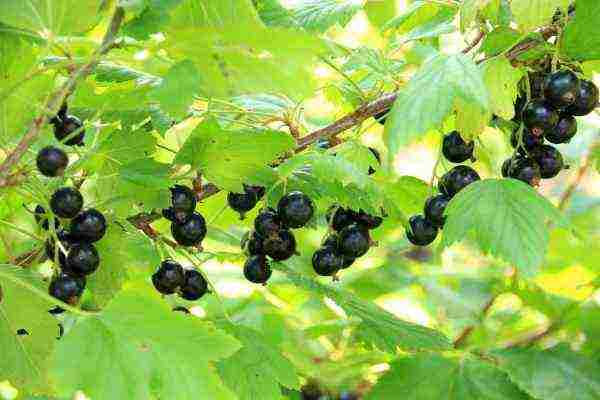
Plant care in spring is not difficult and consists in the following:
- remove the kidneys affected by the mite;
- dig in the bushes and mulch the soil with humus or manure around the bushes;
- ensure sufficient watering during the growth and flowering period;
- remove weeds and loosen the soil under the plants to a depth of 6 cm, 2-3 times a week.If the soil around the bush is mulched, loosening is not required;
- after winter, carry out sanitary pruning of currants;
- treat bushes from pests and diseases in early spring;
- apply nitrogen fertilizers;
- during the flowering period, observe and inspect the flowers. If double inflorescences are found, remove them to avoid spreading to other bushes.
Summer currant care
Watering plays an important role in the care of currants in the hot summer. Also keep an eye on the cleanliness between the bushes, remove weeds on time. Fertilize with organic fertilizers, together with watering. Inspect the bushes all the time, and if pests or diseases are detected, take action, but do not treat with chemicals three weeks before the berries ripen, do with folk remedies. When the berries begin to sing, they need to be picked individually and selectively - only ripe as they ripen.
Currant care in autumn
After harvesting, be sure to water the currants, you also need to loosen the soil. In the second half of September, apply fertilizers: organic and mineral, also carry out formative pruning of currant bushes. In the fall, you need to do the reproduction and planting of currants. For the winter, they carry out preventive treatment against pests and diseases.
Treatment against pests and diseases
In early spring, even before the kidneys swell, treat with a 1% solution of karbofos, copper sulfate or Bordeaux liquid. The soil also needs to be processed. In autumn, remove all fallen leaves from the site with currants, pests will not be bred in them. Carry out preventive treatment with the same drugs in the fall.
Watering currants
After a snowy winter, plants do not need abundant watering. Otherwise, if there was little snow, it is necessary to water it regularly. During the period of growth, formation of ovaries and ripening of berries, water the plants with warm water every 5 days. Water consumption is approximately 20-30 liters per 1 m2 of plot, the soil should be soaked to a depth of 40 cm. In case of dry autumn, water the currants abundantly for the winter.
Feeding currants
The new bushes planted this year have enough fertilizer for growth and development, but when they are 2 or more years old, they need to be fertilized regularly. Apply nitrogen fertilizers in the spring. For two-year-old plants: 40-50 g of urea, for 4-year-olds or more, 20 g will be enough.
In the fall, apply 4-6 kg of organic fertilizer under each bush - manure, compost, chicken droppings. To organic add 50 g of superphosphate and 15 g of potassium sulfate.
Experts recommend carrying out foliar dressing three times in the summer (June-July) with the following solution: dilute separately 3 g of boric acid, 35 g of copper sulfate, 5 g of potassium permanganate, mix everything with 10 liters of water. After sunset or a cloudy day, spray the bushes with the composition.
When and how to cut currants
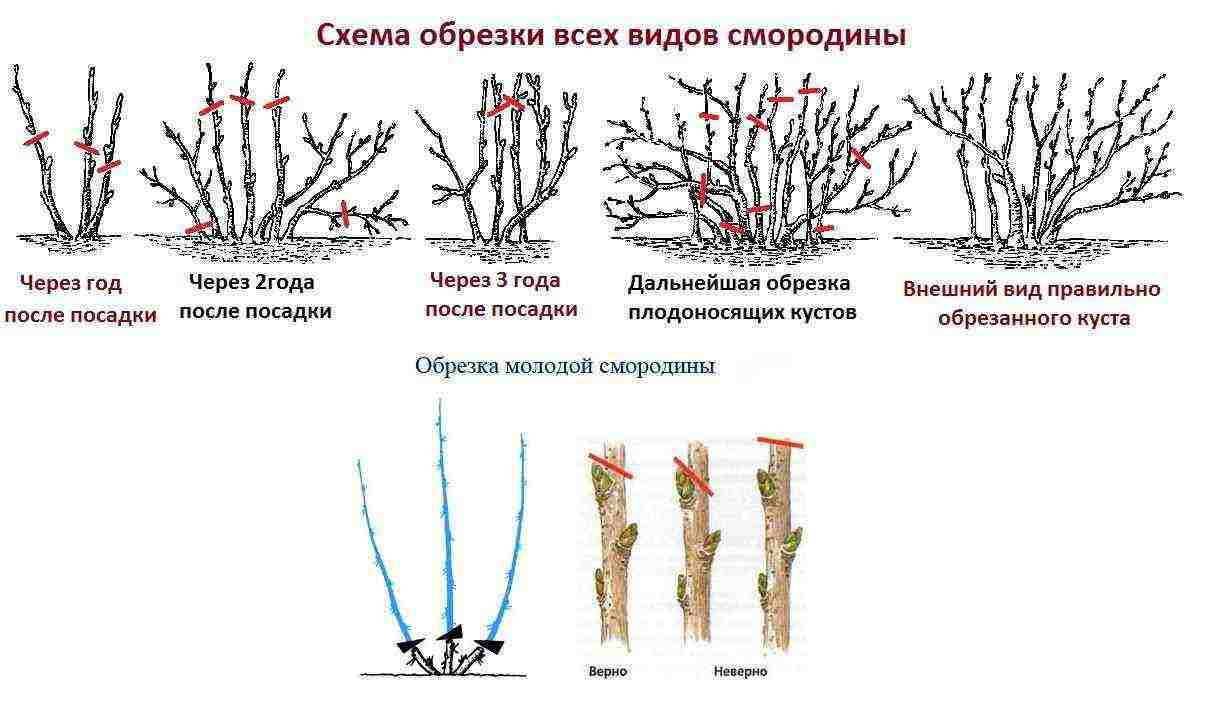
Spring currant pruning - carried out to achieve good yields, remove unnecessary and weak shoots, so the plant does not spend energy on them. Last year's growths on branches 4-5 years old bring the most ovaries. Branches over 6 years old should be pruned. Dried and diseased branches are pruned. In the spring, before bud break, the shoots of frozen and broken branches are shortened, and the main pruning is carried out in the fall, after the leaves have fallen off.
Pruning in the fall - the shoot of the first year is cut at a height of 10-15 cm from the soil level. Two-year-old bushes free from zero shoots, leaving 3-5 strong branches. 3- and 4-year-old bushes are freed from zero shoots, leaving 3-6 most developed ones. Try to cut underdeveloped and weak shoots in the middle of the bushes. On last year's branches, the tops are pruned, 2 and 3-year-old branches are left with 3-4 buds on each branch, the rest is cut off. Branches over 6 years old are removed completely. The pruning diagram is shown.
Correct pruning of currants - video
Reproduction of currants
Black currants are propagated by lignified or green cuttings.
Lignified cuttings
This is the most affordable and convenient way - there is planting material at any time of the year. You can plant cuttings for rooting from spring to autumn. The length of the cut cuttings is about 20 cm and 8-10 mm thick (the middle of annual shoots, shoots growing from the root or 3-year-old branches are suitable), it is advisable to cut from healthy plants.
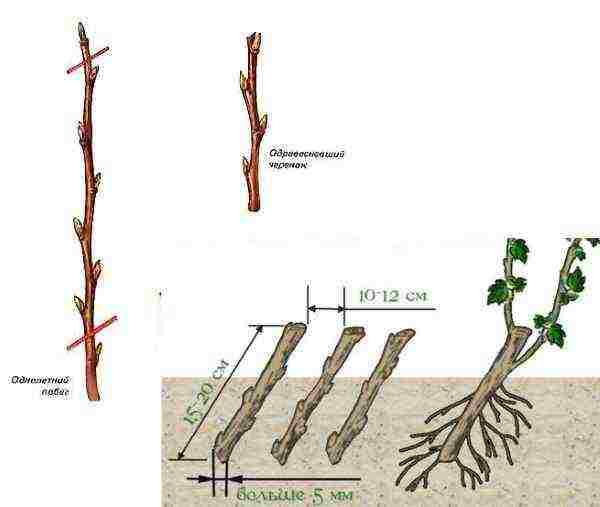
When cutting cuttings, the upper cut is made above the bud at a distance of 1 cm with a sharp secateurs, at the bottom is a cut under the lower bud.
Most often, cuttings are planted in the spring, but it is better to plant cuttings in the fall, when the buds enter a dormant period: for black currants, this is mid-September - early October.
Cuttings are planted at a distance of 10-15 cm between plants and 40 between the rows, this makes it possible to care for currants in the summer and it is convenient to dig them out for planting in a permanent place. It is better to mulch the soil with humus 3-5 cm, so you will prevent the soil from drying out. Also a good option would be to use a film in which holes for the cuttings are pre-made. Watering is needed in moderation, do not allow the soil to dry out. In the summer, remember to feed the beds with mullein and weed.
If the bushes have time to form by the fall, they can be transplanted to a permanent place, if not, leave it for another season.
Green cuttings

Green cuttings are rooted only in a greenhouse. Cutting length 5-10 cm with three green leaves. The cuttings are placed in water to form roots and after 2 weeks are transplanted into a light soil mixture from peat. During the first 3 weeks, spray the cuttings with water for better survival. After 1 month, the film can be removed, if the leaves remain green and elastic, the film is removed completely.
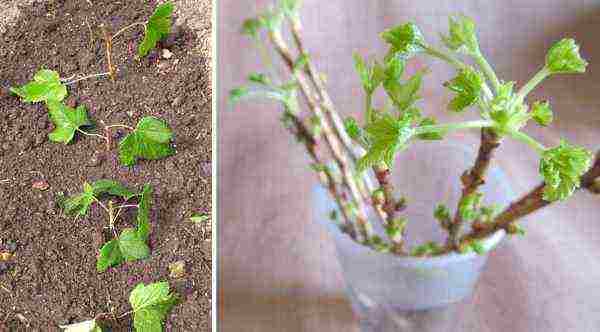
Fight against diseases and pests of black currant
Diseases of the currant
List of common currant diseases:
— septoria - white spot, angular or round spots on the leaves, first brown, then light with a dark border;
— anthracnose - small spots with small bumps of brown color, the leaves dry and fall off starting from the lower branches;
— terry - you can see the ugly flowers of a lilac hue, and the leaves on the young shoots have become dark, the currants cease to bear fruit;
— gray rot - brown spots on currant leaves;
— powdery mildew - white loose bloom on berries and leaves, which turns into a brown film;
— striped mosaic - you can see a yellow pattern on the leaves around the main veins;
— columnar rust - appears on the leaves: on the upper side there are small yellow specks, on the lower side there are outgrowths with yellow spores in the form of hairs.
Treatment can not always give a result - viral diseases are not cured. The best prevention is proper care of currants throughout the season and response to the slightest manifestations of disease. For prophylaxis, spray the soil and black currant bushes with solutions of Bordeaux liquid, karbofos or copper sulfate in early spring before the buds swell.
Currant pests
Pests of currants, the types that can be found often:
— pale-footed sawfly - its caterpillars dine on the leaves, leaving only veins;
— biennial leaf roll - damage buds and berries;
— moth - berries that are damaged ripen ahead of schedule;
— shoot aphid - damages leaves by feeding on sap. Leaves curl, dry, shoots stop growing, bend;
— kidney mite - damages the kidneys, climbing into them for the winter and eating away from the inside;
— spider mite - leaves of steel of marble color, dry up and fall off;
— gall midges - they eat out currant shoots from the inside, which leads to their death. Flower gall midges damage the buds, after which they fall off;
— fruit sawfly - causes damage to black currant berries, berries take a faceted shape.
Each type of pest is fought as soon as they appear on the bushes. Means for processing can be folk, or chemicals - decide what to choose for yourself. But after carrying out prevention in early spring, when all the snow has not yet melted (the buds are still at rest), pour boiling water over the currant bushes from the watering can. Thus, you will destroy pests on the branches and in the ground under the bushes. After the snow melts, process the soil and bushes with Bordeaux liquid or copper sulfate.
Care and pest control without chemistry - video
Currant varieties
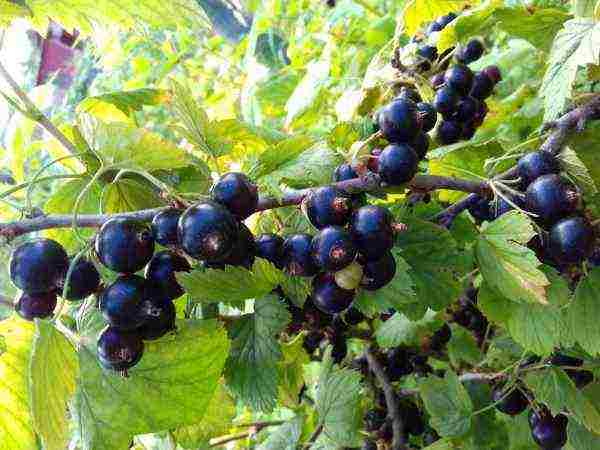
Winter-hardy varieties are suitable for growing in the northern regions - Kent Goliath, Leah fertile, Neapolitan.
It can also be divided into early, middle and late varieties according to ripening.
The most popular varieties:
— Belarusian sweet - early, self-fertile variety with large berries, resistant to kidney mites and anthracnose;
— Premiere - an early variety with large berries of a dessert flavor. High productivity. Resistant to ticks;
— Moscow - early variety, hardy, self-fertile with large berries and average yield;
— Boscopic Giant - mid-early variety with large sweet and sour berries;
— Primorsky champion - an early variety with powerful bushes, wrinkled leaves and large round fruits on long clusters. They have winter hardiness and high productivity;
— Enchantress - the average ripening period of berries, a low bush with large shiny fruits. High yield, resistant to pests and diseases;
— Treasure - a medium variety with a short bush and tasty, large berries. High-yielding variety. Moderately resistant to powdery mildew and kidney mites;
— Oryol Serenade - mid-late variety with medium-sized berries, high yield. Resistant to diseases and pests;
— Gross - late variety with a higher than average bush height. Large berries weighing 5 g, high yield. Resistant to fungal diseases and moderately resistant to ticks;
— Kent - late variety with undersized spreading bushes and large leaves. Berries are large, sour in taste, high yield.
This is a small part of the listed blackcurrant varieties from the whole variety, you make a choice based on the weather conditions in your region.
Good yields of berries!
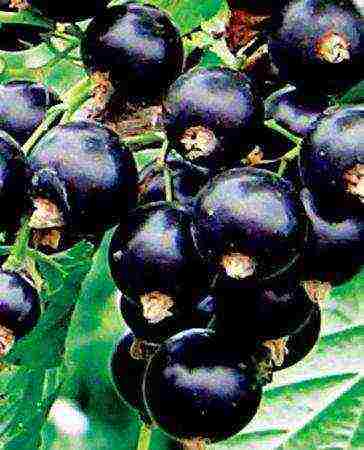
Many summer residents on the site can see currant bushes, but not every summer resident can boast that these bushes give a rich harvest. Perhaps the fact is that the gardener simply does not know how to care for currants. It is not enough just to plant bushes and wait for berries, you need to regularly weed the currants, remove shoots, fertilize and spray this culture. Any plant in the garden and vegetable garden must be constantly looked after, only then will it thank its owner with a generous harvest.
The currant begins to bear fruit already in the second year after planting, and after three years it is already possible to harvest quite a decent harvest from young bushes. Gardeners need to know that old bushes, which are more than 15 years old, already give much less fruit, so the bushes need to be updated in a timely manner. If the bushes are located too close to each other, then they will receive less light, nutrition, and, therefore, the harvest from thickened plantings will be poor.
How to care for currants to get a good harvest every year?
- it is necessary to regularly loosen the bushes;
- destroy weeds;
- fertilize the soil;
- cut off dead branches;
- protect against diseases and pests;
- update old bushes with new ones.

Throughout the summer, the soil in the bed with currants should be loose, but loosening must be done carefully so as not to damage the roots of the currants, which are often located close to the ground. Frequent loosening can be dispensed with if a layer of organic mulch of about 5 cm is spread under the bushes. While the garden is young, currant bushes require shading, they do not tolerate heat well.
In the spring, after the snow has melted, the roots of the currants begin to grow actively, they have enough nutrition and moisture, but in dry summer weather they need watering about once every 5 days, the water for irrigation should be warm. Many gardeners make a common mistake - watering the bush from above, this is wrong, since wetting the leaves can lead to the development of powdery mildew.
There are horticultural societies where black currants are heavily affected by powdery mildew and glassy mildew. In this case, they resort to special agrotechnical methods of cultivation.
First of all, three-year branches are annually cut out from currants, preventing the appearance of branches older than this age. Then dill and garlic are planted around the currant bushes, the earth is mulched. But this is applied after the bushes are formed.
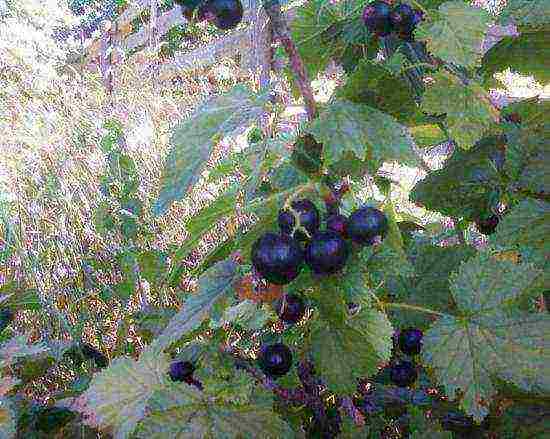
It is better to form them within three years. The most impatient gardeners, of course, take two years. To do this, currant cuttings are planted at once in 3 copies in a prepared pit filled with compost. The seedlings are laid almost horizontally, with a slight slope. In autumn, the entire growth is cut off, about 3 buds are left on each young bush.
In May, strong young shoots will appear, which also need to be cut low in the fall.
Further, all care comes down to pruning weak branches and three-year ones, annual mulch renewal, and garlic replanting. Dill itself will win a place under the currant bushes.
If in Siberia currants bear fruit on five-year-old branches and older, then it is clearly less adapted to the southern growing zones. Therefore, the Morozov method can be applied. In this case, the currants are planted in two rows. This year, annual shoots are left in the same row, which bear fruit successfully. Then they are cut low in the fall. The next year, the harvest is removed from another row, where one-year-old currant branches are left. In the fall, they are also cut off.
A smart method that solves both "southern" problems: the glass case does not have time to gnaw out the wood, and the fungi do not get anything either. Planting bushes can be dense, since the annual alternation of regrown branches will not interfere with their development.
Care for red, white and golden currants and hybrids

These crops are less susceptible to glass attack. The main crop of currants is obtained not on one-year-old branches, but on 2-4-year-old ones. The annual growth rate is much less than that of black currant.
For a more lush growth of bushes in one planting pit filled with compost, it is advisable to plant three bushes. Rejuvenation of the bushes is simply necessary, otherwise the bushes will soon die.
Yoshts and kronals (hybrids of currants and gooseberries) generally yield only after four years of cultivation. They throw out powerful growths that must be constantly held by pinching. Now they are not very popular, they have been preserved mainly in old gardens.
So, the main features of currant care are watering, regular rejuvenation of the shoots from the roots and special agricultural practices to curb the spread of diseases and pests. The methods described are not overly time-consuming, but still require your input annually.
>
